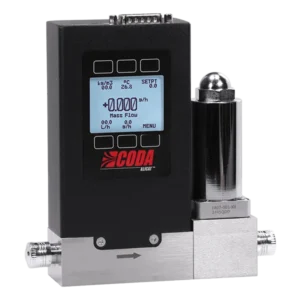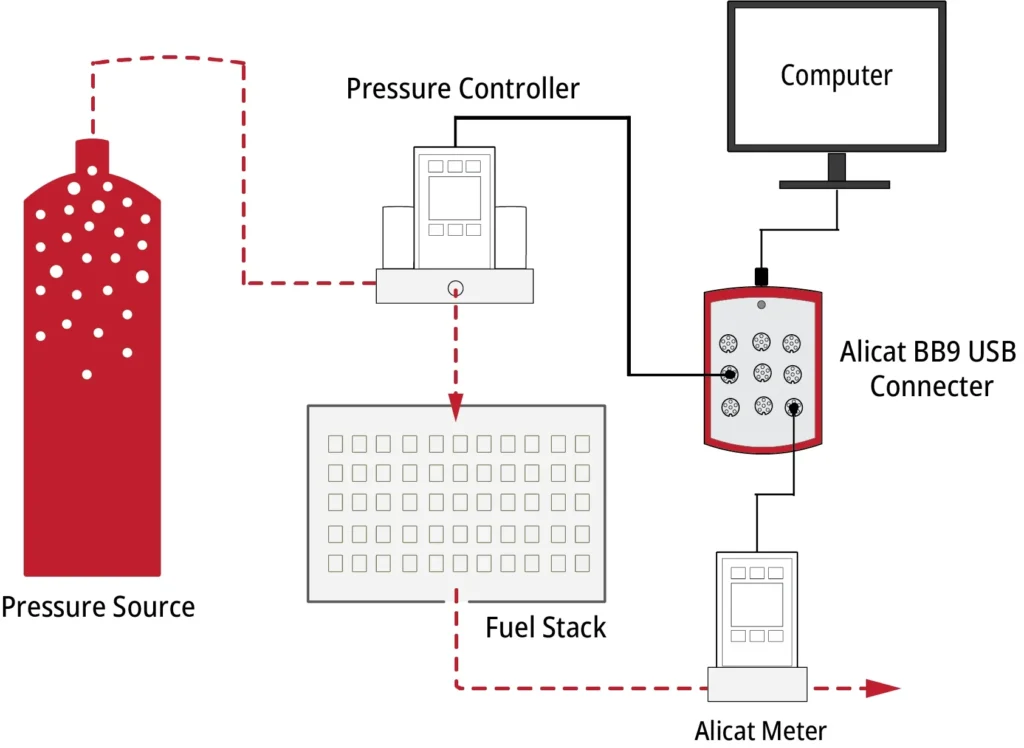Fuel Cell Testing: Flow and Pressure Solutions
Precise and adaptive regulation of system pressures and the mass flow of gas lines can make all the difference in developing an efficient hydrogen fuel cell system. In this article, we cover the various sensing technologies in fuel cell applications and discuss how mass flow and pressure devices are used to optimize these technologies.
Fuel cell testing & regulation
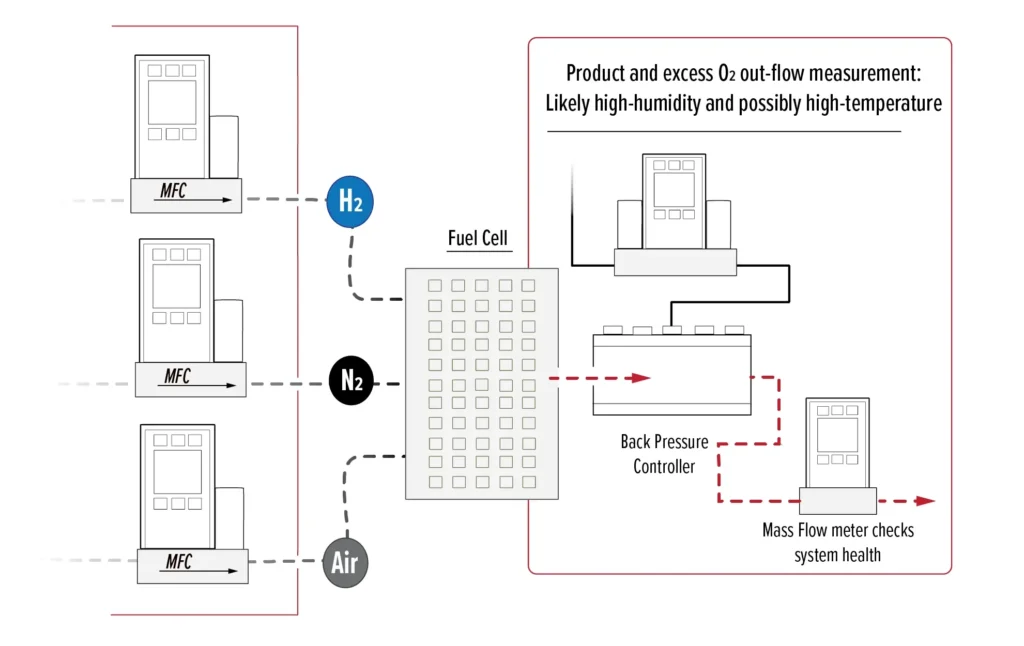
Figure 1. Using Alicat solutions for fuel cell system testing & optimization
Fast and accurate instruments throughout the fuel cell system make life much easier when conducting PEM fuel cell testing and diagnosis, and large turndown ratios allow processes to be easily scaled through the development process.
Regulating oxidant and reactant ratios and distributions across gas diffusion layers of stacks is key to maintaining the efficiency of hydrogen fuel cell technology, making reliable and fast responding flow regulation an invaluable asset to fuel cell test benches.
When process conditions include high pressures and low flow rates, a Coriolis mass flow controller is a reliable, high-accuracy option. For higher flow rates of mainline inputs and outputs, a differential pressure (DP) mass flow controller can be used to monitor both pressure and mass flow simultaneously over a wide range of flow rates. It is also important to maintain tight back pressure control, which can be difficult in environments with high temperature, high humidity, and moisture.
Like in electrolysis, a multi-orifice back pressure regulator is well suited to maintain ideal reaction conditions in fuel cell systems, allowing pressure regulation down to 0.0001 PSIG in most testing conditions. We also offer stainless steel DP mass flow meters that provide fast and accurate mass flow readings, unaffected by moisture passing through the unit.
Products Referenced ...
CODA Coriolis mass flow controllers precisely control DI water or high pressure gases.
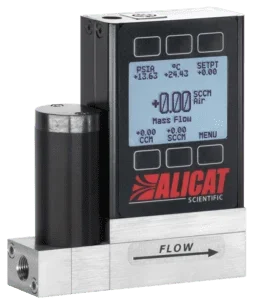
DP mass flow controllers can be used to monitor both pressure and mass flow simultaneously for over 98 gases
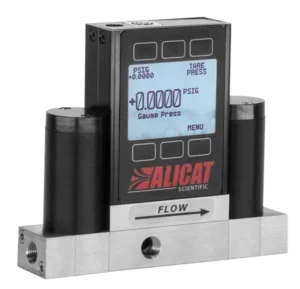
Dual-valve pressure controllers reach setpoints in milliseconds and maintain control without continuous bleeding

Stainless steel DP mass flow meters are unaffected by moisture passing through the unit.
Fuel cell testing & regulation
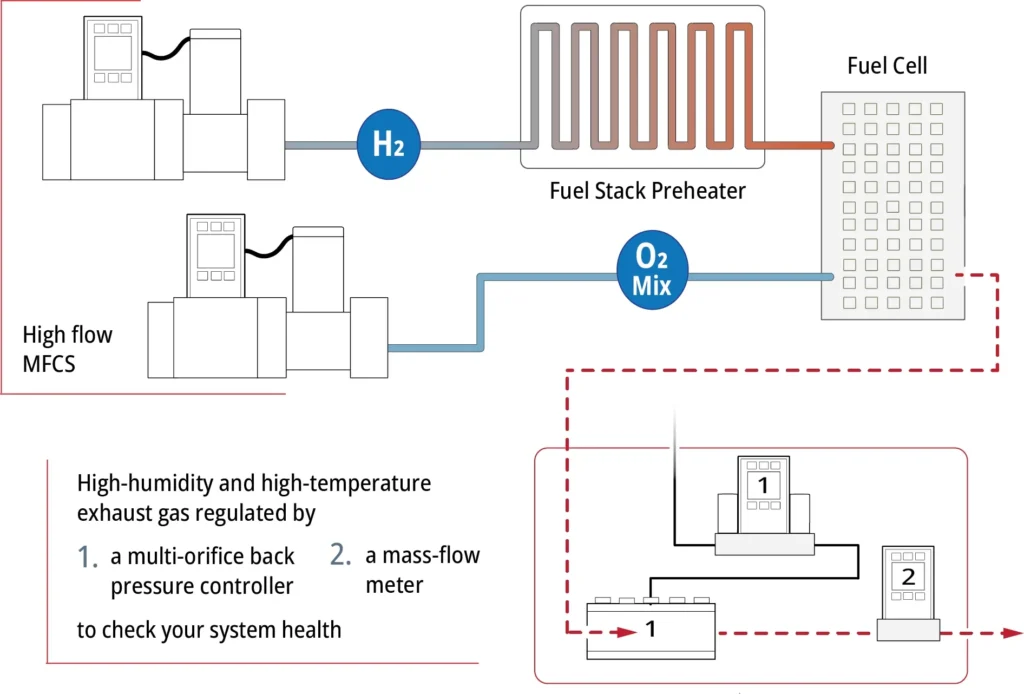
Figure 2. Using Alicat controllers for fuel cell system regulation & monitoring
Yet another challenge is regulating temperature across the stack to maintain a consistent rate of power distribution. Improper regulation can cause efficiency losses and even damage to the stack elements. This challenge becomes increasingly more difficult as the number of cells increase. Incorporating differential pressure mass flow controllers with <50 ms response times and 10,000:1 turndown ratios can ensure fast, stable temperature regulation.
Humidification is equally important to ensure efficient proton conductivity across the electrolyte layer as an excess or deficit of water can greatly impact fuel cell efficiency.
Once optimal gas ratios, flow rates, pressure, and temperatures have been established, Alicat solutions can be used to regulate and monitor your finished fuel cell systems.
Pressure regulation units can be used in combination with external sensors to regulate pressure upstream of the sensor position. In high temperature, high humidity lines, remote sensors and valves can also be employed for pressure regulation. Fast response times and turndown ratios of up to 10,000:1 ensure that pressure and mass flow controllers can precisely control hydrogen flow into pre-heating systems and maintain fuel cell system efficiency. Meanwhile, a multi-orifice back pressure regulator maintains exhaust gas output.
Products Referenced ...

DP mass flow controllers mimic fuel cell behaviors at full scale flow rates up to 12,000 SLPM with quick response and high accuracy.

Dual-valve pressure controllers reach setpoints in milliseconds and maintain control without continuous bleeding.
Leak checks and membrane permeability tests
Figure 3. Fuel cell system leak check setup
Leak checking fuel cell systems – especially membrane leak and permeability testing – is vital for ensuring consistent flow rates, maintaining process efficiency, and minimizing loss of reactants such as high value heavy metals in the catalyst layers of membrane electrode assemblies. This can be particularly challenging in larger volume fuel cell systems where testing multi-stage processes can lead to flow spikes during the test process.
Leak check stations are typically composed of two components. The first is a dual valve pressure controller which makes measurements every 30 ms and ensures the element under test remains at a set pressure while minimizing He usage. Meanwhile, highly sensitive PID tuning and setpoint ramping functionality help protect the membrane from flow spikes during testing. This is combined with a low pressure drop mass flow meter to characterize the slightest leaks, with a pressure drop as low as 0.07 PSID across the unit. These two instruments can be controlled from a single computer/PLC using an array of communication protocols for easy automation and data analysis
This system is used to increase reliability, repeatability, and speed of helium leak tests on Solid Oxide Fuel Cell (SOFC) membranes. There are two Alicat units, one dua-valve pressure controller, replaced a manual regulator and a mass flow meter which replaced a simple bubble meter.
With the automatic adjustments in as little as 30 milliseconds to ensure highly repeatable tests. The Alicat controller automatically compensates for density effects due to line pressure and temperature changes, ensuring a safe and repeatable process.
Data communication for the dual-valve pressure controller and the mass flow meter with a single PC allows for easy automation and data storage.
Products Referenced ...

Dual-valve pressure controllers reach setpoints in milliseconds and maintain control without continuous bleeding.

Low pressure drop mass flow meters fuel cell behaviors at full scale flow rates up to 10,000 SLPM with quick response and high accuracy.
Solutions for other areas of fuel cell research
For the many other processes and tests that are required in areas relating to hydrogen fuel cell system R&D (e.g. catalyst verification and electrode testing) we have a range of custom mass flow and pressure solutions using a variety of technologies.
If you have any questions about solutions for hydrogen fuel cell regulation and testing, contact our applications engineers to find a solution for your process needs.
Alicats in Action
Automating fuel cell test stands
Alicat flow and pressure controllers are both handy in the lab and easy to automate. The combination of a user-friendly display and protocols like EtherNet/IP streamlines integration into the testing systems, while increasing the precision and reliability of tests.
Ludlow Electrochemical Hardware automates fuel cell test stands

Fuel cell system modeling
Data output from a range of instruments allows accurate modeling of fuel cell systems. Each Alicat mass flow instrument simultaneously monitors mass flow, volumetric flow, pressure, and temperature readings with response times as low as 10 ms.

